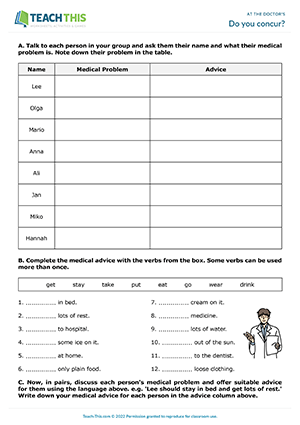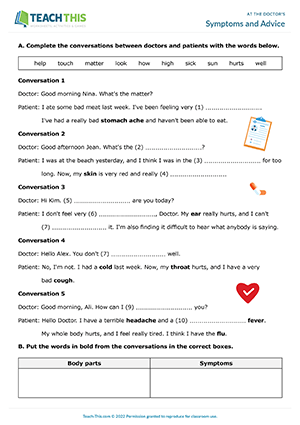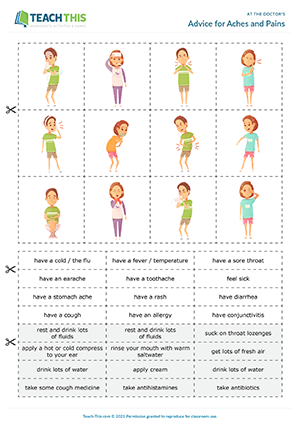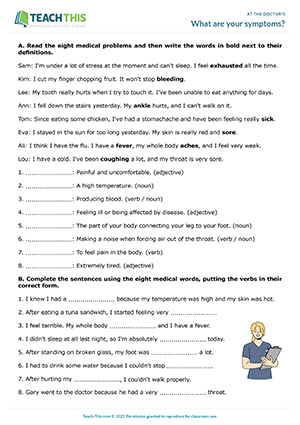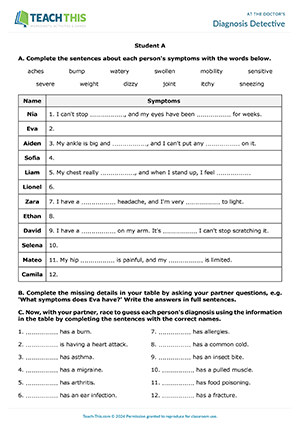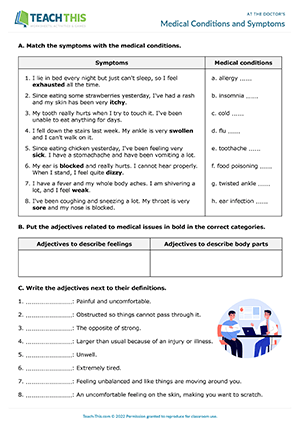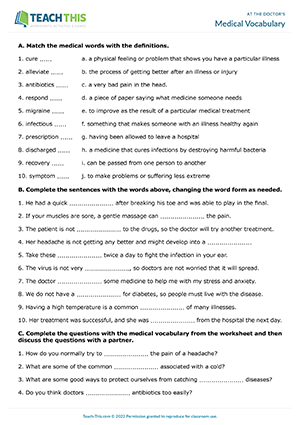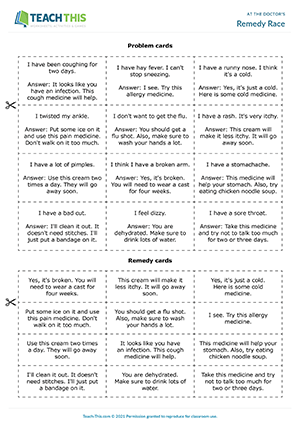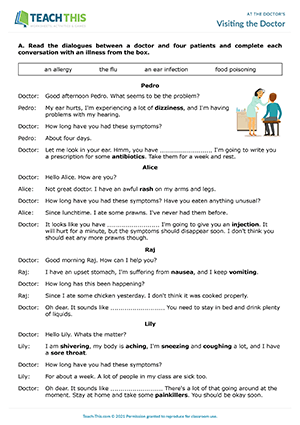In this useful medical advice speaking activity, students practice talking about basic medical issues and giving corresponding advice. First, students do a quick role-play activity where they assume the identity of a sick person and speak to each person in their group to ask them their name and what their medical problem is, noting each medical issue down in a table. Working alone, students then complete medical advice with verbs. Next, in pairs, students discuss each person's medical problem and offer advice for them using the language from the worksheet, e.g. 'Lee should stay in bed and get lots of rest.' Afterwards, review the medical advice the pairs gave for each person as a class.
This comprehensive At the doctor's worksheet helps students practice vocabulary and language for describing symptoms and giving medical advice. Students begin by completing conversations between doctors and patients with the words shown. Next, students categorise the words in bold from the conversations into body parts and symptoms. Students then match medical advice to the people in the conversations. After that, students unscramble sentences and then place them in a doctor-patient conversation. Lastly, students practice their own doctor-patient conversations, choosing different symptoms, and taking turns to be the patient and the doctor each time.
In this free giving health advice game and role-play, students match pictures to health problems, and health problems to treatments, and role-play giving health advice as a doctor. In pairs, students take it in turns to turn over one picture card and one health problem card. If the picture and health issue match, the student keeps the cards and has another turn. The student with the most pairs of cards at the end of the game wins. Next, students repeat the game, but this time they use the health problem cards and treatment cards, matching the health issues with the treatments. Afterwards, the pairs role-play short doctor-patient interactions. Students take it in turns to turn over a picture card and act as a patient, saying the health problem shown in the picture, e.g. 'I've got a cold'. The other student acts as a doctor and gives health advice to the patient, e.g. 'You should rest and drink lots of fluids'. When the students have finished, they role-play some of their interactions in front of the class.
This productive At the doctor's worksheet helps students learn a variety of vocabulary used when visiting a doctor. First, students read eight medical problems and match words in bold with their definitions. Next, students complete sentences using the medical vocabulary. Students then complete medical advice using the vocabulary provided and write the name of the person from Exercise A that each piece of advice is for. After that, students complete a doctor-patient conversation with vocabulary from a box and then practice the dialogue with a partner, changing the symptoms and advice. Lastly, students discuss medical conversation questions with their partner.
In this medical vocabulary activity, students complete sentences about patients' symptoms and exchange information to diagnose each person's condition. First, in two groups, students use the words provided to complete sentences about different people's symptoms. Next, students pair up with someone from the other group and take turns asking their partner about the symptoms experienced by the people whose details are missing from their worksheet and writing their partner's responses in the table in sentence form. After that, pairs race to complete sentences by writing each person's name next to the correct diagnosis based on their symptoms. The first pair to complete all their sentences correctly wins.
In this insightful health vocabulary worksheet, students practice words related to medical conditions and symptoms. To begin, students match symptoms with medical conditions. Next, students put adjectives related to medical issues in the correct categories. Students then write the adjectives next to their definitions. After that, students match the symptoms mentioned in Exercise A with definitions. Students then move on to match the medical conditions with appropriate advice. Lastly, students complete a doctor-patient conversation with the words provided.
Here is a handy medical vocabulary worksheet for upper-intermediate students. Students begin by matching medical words to their definitions. Next, students complete sentences with the medical words. Lastly, students complete questions with the medical vocabulary from the worksheet and then discuss the questions with a partner.
In this free doctor and patient role-play game, students race to suggest remedies to basic medical problems. In groups of three, students take it in turns to take on the role of a patient and pick up a problem card. The other students take on the role of doctors and ask the patient, 'What's the matter?' The patient then reads out the problem on the card, and the doctors race to find the correct remedy card and read it to the patient. If the remedy is correct as shown on the patient's card, the patient replies, 'Thank you, doctor.' The winning doctor then keeps the problem and remedy cards. If the remedy is incorrect, the patient replies, 'Can I have a second opinion?' The other doctor then chooses a different remedy card. The student with the most cards at the end of the game is the winner.
In this engaging At the doctor's worksheet, students learn and practice vocabulary and language associated with visiting the doctor. First, students read dialogues between a doctor and four patients and insert one of the illnesses shown into each conversation. Next, students complete sentences about the dialogues by writing the correct person's name. Students then put the words in bold from the doctor dialogues into two categories, symptoms or treatments. Students then move on to match the symptoms and treatments with definitions. Lastly, students work with a partner and ask them questions about the last time they visited the doctor.
Latest Free
Resources
- Everyday Objects Bingo
Everyday Objects
Elementary (A1-A2)
- Action Verb Races
Actions
Elementary (A1-A2)
- Birthday Basics
Birthdays
Elementary (A1-A2)
- Sales Phrasal Verbs
Business Phrasal Verbs
Upper-intermediate (B2)
Latest Member
Resources
- Collocations at Work
Business Collocations
Intermediate (B1)
- Etiquette Trivia Board Game
Etiquette and Manners
Upper-intermediate (B2)
- Everyday Objects Vocabulary
Everyday Objects
Pre-intermediate (A2)
- Let's have a talk
Verb-Noun Collocations
Pre-intermediate (A2)



